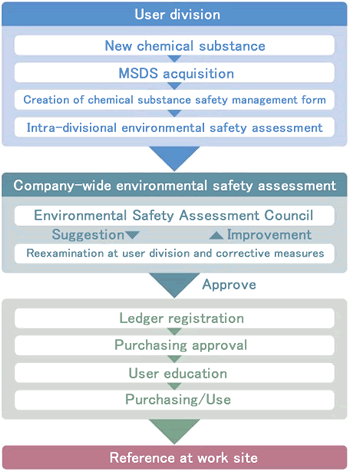Environmental Report 2009
Chemical Control and PRTR Data
To control the risks associated with chemicals, JAE appoints legally designated managers and qualified personnel that have been deemed the most suitable, with consideration given to their division and age. In each division, rigorous management is led by personnel appointed as chemical substance managers, chemical substance controllers, and chemical substance handlers. And to prepare for emergencies, the company clearly specifies the parties to notify, including concerned divisions onsite, and also conducts drills.Chemical Substance Management
The introduction of a new chemical substance or piece of equipment, construction work, increased waste volume, and other changes require an environmental safety assessment under JAE's in-house pre-assessment system. For chemical substances, it has prepared an ad hoc chemical substance safety management form for the entry of requisite information on items including transport, storage, handling, and disposal. JAE uses this form for inspecting chemical substances, which cannot be purchased unless they pass this inspection and are registered.The following table presents data for chemical substance registration in FY 2008. JAE inspects and registers many chemicals for R&D and process improvement. In conjunction with this, it also reviews the use of unnecessary chemicals. With the total number of items growing in recent years, the company has been aggressively trying to implement further cuts in the number and volume of unnecessary chemicals.
■JAE Akishima Plant
| 2006 | 2007 | 2008 | |
|---|---|---|---|
| Number registered | 2,049 | 2,093 | 2,215 |
| Discontinued | 125 | 128 | 48 |
| New | 91 | 172 | 170 |
| Number of distinct chemical substances registered | 1,597 | 1,664 | 1,733 |
the same chemical substances may be registered on a per usage basis.
■Pre-assessment flowchart for new chemical substances

PRTR Data
The table below shows the change in the volume of PRTR-designated chemical substances used. The table's values are totals for five domestic manufacturing companies, and the number of stars (★) corresponds to the number of production sites subject to PRTR reporting. In compliance with the RoHS directive, JAE has been reducing hexavalent chromium and lead-containing chemical substances year by year, but the reductions started to flatten out in FY 2006. Usage outside RoHS targets is decided by customer demand, and the increase of lead in FY 2007 was a direct result of that.Antimony trioxide may be included in the molding material for connectors due to its flame retardant properties, and FY 2007 saw a three-fold or greater rise in antimony and its compounds. This was the direct result of the increased production of new products containing antimony trioxide and does not mean that JAE was purposefully selecting molding materials with a particularly high content. Since reducing waste is also crucial in dealing with PRTR-targeted chemical substances, JAE is promoting recycling to offset the rise in the amount of molding materials and lead it uses.
As shown in the table, JAE uses few PRTR-designated chemical substances and in relatively small amounts, but is nevertheless actively using the electronic reporting system.
■Change in Volume of PRTR-Designated Chemical Substances Used Unit:tons
| Fiscal | 2008 | 2007 | 2006 | 2005 |
|---|---|---|---|---|
| Antimony and its compounds | ★★19.9 | ★★11.2 | ★★3.5 | ★2.8 |
| Inorganic cyanide compounds | ★2.1 | ★2.7 | ★2.6 | ★2.0 |
| Hexavalent chromium compounds | 0.14 | 0.16 | 0.17 | 0.41 |
| Nickel | ★5.8 | ★7.7 | ★6.8 | ★7.5 |
| Nickel compounds | ★1.9 | ★2.7 | ★★2.8 | ★2.4 |
| Hydrogen fluoride and its water-soluble salts | ★★4.6 | ★★5.2 | ★★4.2 | ★3.1 |
| Lead and its compounds | 0.30 | 0.21 | 0.11 | 0.16 |
Volatile Organic Compound (VOC) Data
VOC emissions were curbed overall in FY 2008, but the reduction of 31.0% achieved was not significantly better than the government's FY 2010 reduction target of 30%, which means activities for achieving the targeted VOC emissions reduction must continue.
●PRTR
Acronym for pollutant release and transfer register. PRTRs are systems for improving voluntary control of chemical substances by businesses and preventing obstacles to environmental safety through understanding the amount of harmful chemicals released into the environment, including those chemicals for which the effects on the human body have not yet been identified. In Japan, they have been systemized by the Act on Confirmation, etc. of Release Amounts of Specific Chemical Substances in the Environment and Promotion of Improvements to the Management Thereof (Chemical Control Law).